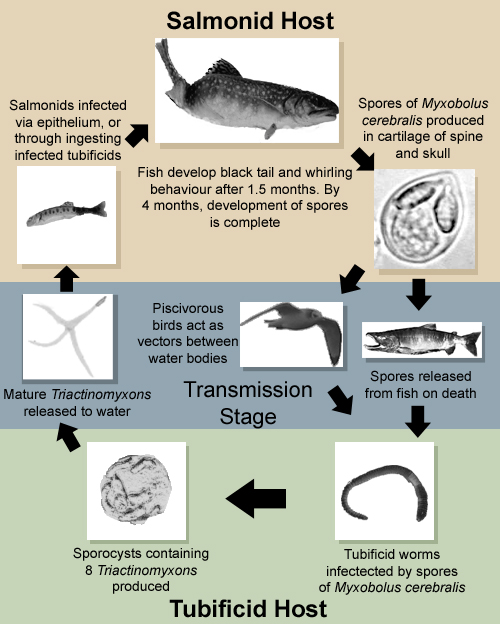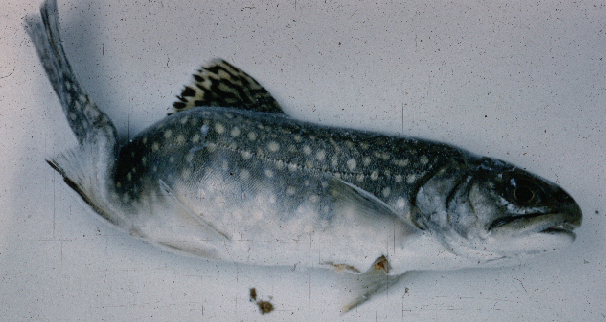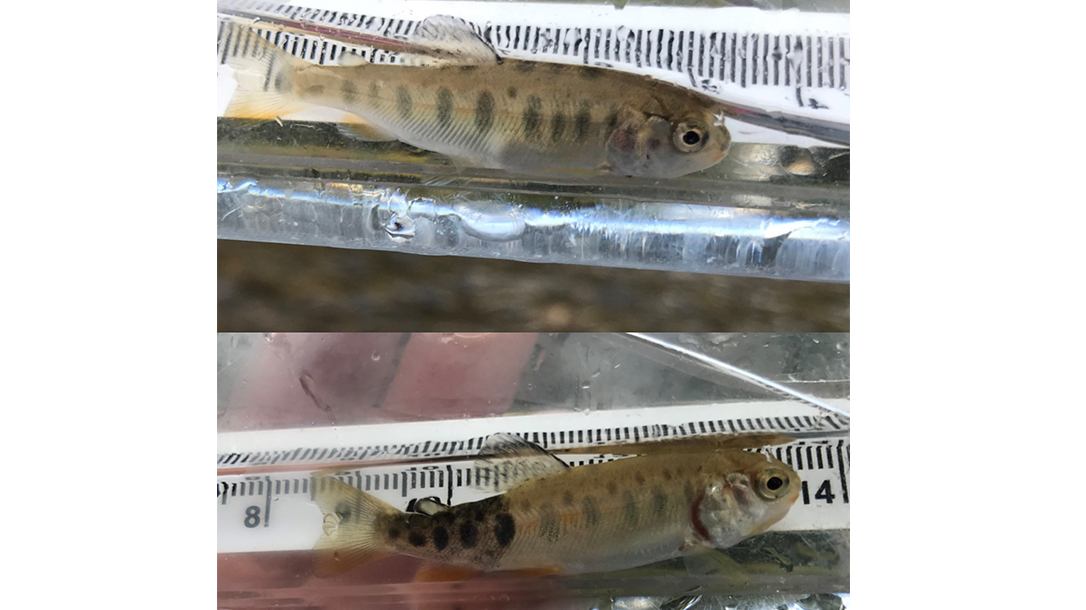Whirling Disease

Whirling Disease
(Myxobolus cerebralis)
Tags: Aquatic
Identification and Reproduction
Biology:
- Myxobolus cerebralis is a parasite of salmonids that causes whirling disease.
- M. cerebralis life cycle includes two-hosts; salmonid fish and a tubificid oligochaetes.
- Often myxospores are ingested by tubificid worms (bottom dwelling worms) and will multiply and infect neighbouring worm segments.
- Spores are released into the water and can enter salmonids through the skin. Fish can also become infected by consuming infected tubificid worms.
- It infects host fish by piercing the cells with polar filaments.
- It resides in the infected fish cartilage and bone.
- Once the fish dies the parasite is released into the water.
- The final life stage of M. cerebralis is in the form of myxospores and causes whirling disease in fish. They are very resilent and can tolerate freezing conditions at -20oC. They can even survive digestion through Northern pike (Esox lucius) and mallards.
Signs of whirling disease:
- Whirling disease infects juvenile fish; fingerlings and fry.
- It causes skeletal deformation and neurological damage.
- Skeletal deformities will be found on the head and body. The head may appear sunken and the tail is often crooked.
- The tail may also appear black and dark since the tail suffers nerve compression.
- Based on the name, it cause infected fish to swim in a "whirled" pattern instead of swimming normally.
Habitat & Ecology
- Typically infects farmed salmon and trout but will also infect wild fish populations.
- Rainbow trout, cutthroat trout and whitefish are more susceptible than other salmonids.
- M. cerebralis is thought to be spread through infected fish, through natural migration or human influenced activities.
- Fish, birds and mammals can also help spread the parasite to new water systems by consuming infected fish.
- The aquarium trade is also a vector for the whirling disease. Often infected tubificid worms are found in home aquariums, purposely released contents will lead to new introductions of the parasite.
- Mature myxospores can also be found in sediment and can be carried by angler's and commercial fishing equipment.
- Myxospores can remain dormant in the mud for at least 30 years.
- Currently in Canada, it has only been found in Alberta.
Impacts
- Infected fish swim in a whirled, corkscrew pattern, which makes feeding difficult and increases vulnerability to predators.
- This parasite can cause mortality rates as high as 90% in infected populations.
- There is a huge economic loss associated with whirling disease and farmed fish.
- This parasite causes fish mortalities, reduces fitness and will ultimately reduce the number of fish available for sale and stocking.
- It also causes a financial burden for fish farms that need to quarantine infected fish, disinfect and even renovate facilities.
- Whirling disease can potentially cause large populations to plummet, altering the community compositon in waterbodies.
- Some species have even experienced local extirpation.
Management
- Whirling disease is currently a federally reportable disease. Anyone working with aquatic animals has a legal obligation to report any suspected infected animals to the CFIA, that is of concern to Canada.
- Do not import live infected fish into Canda.
- Never introduce live finfish from another country into natural waters of Canada.
- Be sure to wash and disinfect footwear and clothing after having contact with wild finfish.
- Always clean, drain and dry your gear and watercraft after leaving a waterbody.
Resources
For more information please refer to the CFIA's fact sheet on Whirling Disease here.
Refer to Alberta's fact sheet on Whirling disease for more details on its distribution in Alberta and their response to the parasite here.
View Alberta Environment's educational video on the impacts of Whirling Disease for more help identifying infected fish here.
Header photo (Outdoor Canada).





